
Photo by Vrînceanu Iulia on Unsplash
The 12 Books I Have Read In 2023
A review of the twelve books I read this year
As the year 2023 draws to a close, it will be exciting to share some books I picked up to read and what I learned from them.
As the old saying goes,
"When books are opened, we discover that we have wings" — Helen Hayes.
Now, let's walk through a concise review of these books.
1. Give and Take by Adam Grant
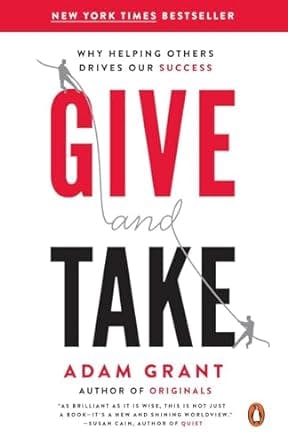
This book describes the impact of generosity on success, suggesting that giving benefits others and fosters personal achievement and fulfillment. It explores the three reciprocity styles—givers, takers, and matchers, and sheds light on their impact and outcomes.
It emphasizes that success isn't just about personal attributes like talent, hard work, or luck but rather influenced by how individuals engage with others. Givers, who prioritize contributing without expecting immediate returns, are central to this narrative. However, they also face the risk of being taken advantage of, especially in competitive environments. Despite these challenges, givers often stand out at both the bottom and top of success metrics.
Grant's insights underline that creating value for others while maintaining personal success is a delicate balance. The book advocates for developing a giving mentality without neglecting personal interests or becoming victimized. Additionally, it highlights the power of networks, suggesting that a strong network built on giving facilitates mutual growth and success.
2. Building A Second Brain by Tiago Forte

This is a guidebook for leveraging digital tools to expand and enhance one's thinking and productivity. It advocates shifting focus from consuming information to creating output, emphasizing that true productivity lies in generating tangible results rather than passively gathering knowledge. The book stresses the art of distilling and saving only the most pertinent information as succinct notes, encouraging the creation of personal repositories of inspiring quotes, memories, and personal reflections for motivation.
The PARA method (Projects, Areas, Resources, Archives) in the book categorizes information into manageable segments, helping users effectively manage short-term projects, long-term responsibilities, future-use topics, and inactive items. It also guides readers through leveraging digital tools via the CODE framework: Capture, Organize, Distill, and Express—a methodology that revolutionizes productivity by capturing diverse ideas, organizing them effectively, distilling the most valuable insights, and transforming them into impactful outputs.
Overall, the book discusses the importance of documenting personal thoughts and the significance of taking action, emphasizing that knowledge gains value only when applied and shared.
3. Web Security For Developers by Malcolm MacDonald
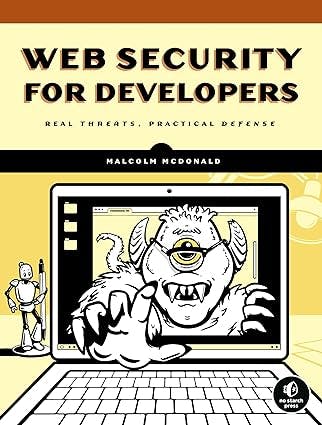
This book equips developers with comprehensive insights into potential threats, their mitigation, and the adoption of security measures essential to building resilient and secure web applications. It delves into critical aspects of web security, focusing on various attack types and methods to fortify against them. It highlights the perils of injection attacks, where external code infiltrates an application, compromising its integrity or accessing sensitive data. It categorizes injection attacks into SQL injection, command injection, remote code execution, and file upload vulnerabilities, explaining their mechanisms and risks.
To combat these threats, the book offers mitigation strategies such as parameterized statements and object-relational mapping (ORM) and emphasizes best practices like thorough testing, careful selection of external resources, and continuous learning about evolving security threats. It also emphasizes the importance of creating user-friendly applications, making cautious selections of external data sources, and implementing robust intrusion barriers.
Additionally, it discusses vulnerabilities associated with HTML5, CSS3, and JavaScript, highlighting risks such as code injection, user tracking, cross-site scripting (XSS), and more. It also explores file upload vulnerabilities, the necessity of secure authentication systems, the role of encryption in safeguarding sensitive information and the significance of understanding and managing application components, staying updated on security threats, and training developers to prioritize security throughout the development lifecycle.
4. Community Building on the Web by Amy Jo Kim

"Community Building on the Web" by Amy Jo Kim provides a comprehensive guide to creating and nurturing thriving online communities by understanding members' needs, establishing engaging spaces, fostering relationships, and maintaining a conducive environment for growth and interaction.
The book outlines four primary types of communities: geographic, demographic, topical, and activity-based. Each type serves a distinct purpose, whether connecting people based on location, shared interests, or common activities. Exploring the importance of identifying an unmet need among members, a crucial factor that distinguishes a thriving community.
It highlights the evolution of subcommunities within larger ones, the importance of understanding visitors' first impressions, strategies for member engagement, the advantages of relationships over content, and the importance of visitor profiling, community themes, and feedback mechanisms to foster a sense of belonging and encourage active participation. It touches upon the idea of community rituals, celebrations, and acknowledging milestones to foster a sense of belonging.
It also addresses legal and guideline considerations, emphasizing the importance of community standards and documenting legal aspects to mitigate risks and maintain a positive environment.
5. Content Everywhere by Sara Wachter-Boettcher
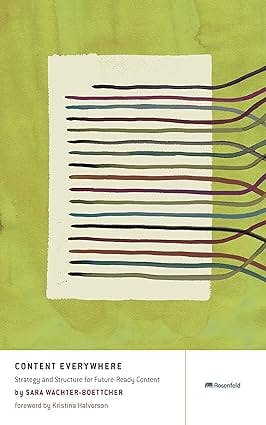
The book "Content Everywhere," explore the act creating robust content structures, optimizing user experiences, and ensuring content accessibility across various platforms for a seamless and inclusive audience experience.
It delves into the fundamental components of information architecture (IA), which serve to define spatial relationships and organizational systems. IA establishes hierarchies, taxonomies, vocabularies, and schema, resulting in tangible documentation such as sitemaps, wireframes, content types, and user flows. These elements facilitate the design of navigation and search systems, crucial for seamless user experiences.
The book explores how elements relate to each other—whether hierarchically as parent and child, interdependently like spouses, or complementarily like friends. For instance, an image and its caption might be interdependent, inseparable entities, while a timeline sidebar could be a child story related to its larger parent feature but easier to detach.
It also highlights the importance of content structure, metadata, and markup in enhancing content discoverability across diverse platforms. It emphasizes the necessity of making content platform-agnostic, ensuring universal accessibility to the same content, regardless of the device or platform users engage with.
6. The Art of Noticing by Rob Walker

In Rob Walker's "The Art of Noticing," the main idea is to pay close attention to the world around us. It's about really looking, listening, and even smelling things deliberately to discover more.
He talks about breaking routines sometimes. Doing things differently, like taking a new route, helps us see things we'd usually miss. Noting details helps us remember better. There's a fun exercise where you look at something, look away, and try to remember everything you saw. Then, when you look back, you see what you missed.
Listening without talking much is important. It helps us connect better with others. Sometimes, asking about strange things around us leads to interesting stories. Helping others makes us feel more capable and satisfied. It's like checking off a special to-do list.
Asking for advice instead of just saying "thanks" can be helpful. It shows we're open to learning from others. Instead of complaining, making things better is the focus. It's like trying to fix what's not working instead of just talking about it. Taking time before replying to something annoying helps us respond better. It's about staying calm.
Finally, noticing small things and learning about everyday stuff we take for granted makes life more interesting. It's all about paying attention and discovering the stories hidden in ordinary things.
7. The Cryptopians: Idealism, Greed, Lies, and The Making of the First Big Cryptocurrency Craze by Laura Shin

The book delves into the rise of cryptocurrencies, particularly focusing on the people involved and the events that shaped the industry. It explores the stories of key figures like Vitalik Buterin, Mihai Alisie, Anthony Di Iorio, Gavin Wood, Jeffrey Wilcke, Charles Hoskinson, Joe Lubin, and other driving forces behind Ethereum and other revolutionary blockchain technology projects.
The book provides insights into the motivations, conflicts, and controversies within the crypto world, shedding light on both the idealistic aspirations and the darker sides of the industry. It starts with Vitalik's introduction to Bitcoin, his contributions to Bitcoin Weekly and Bitcoin Magazine, and the significant surge in Bitcoin's price, which fueled Vitalik's vision for Ethereum. As Bitcoin's value soared, Vitalik shared his Ethereum white paper with friends, leading to the development of the first implementations by Jeff Wilcke and Gavin Wood.
The addition of Jeff, Gavin, and Joe as co-founders marked a pivotal moment in Ethereum's evolution. Stiftung Ethereum's establishment and the subsequent crowd sale laid the foundation for Ethereum's journey. Concurrently, the creation of the initial version of MyEtherWallet in 2015 underscored the burgeoning potential of this nascent platform. Key meetings, such as the gathering in London attended by influential figures in the Ethereum sphere, Christoph Jentzsch's demonstration of Slock.it, and the announcement of The DAO.
But things weren't smooth sailing. There were internal conflicts, like Gavin's firing, and external problems, like a hacker exploiting a part of Ethereum called The DAO and causing chaos. This led to debates on how to fix things, splitting Ethereum into two: Ethereum and Ethereum Classic (ETHC) and triggering a series of events, such as the accidental transfer of funds to the DAO post-fork.
8. The Missing Crypto Queen by Jamie Bartlett

In the book “The Missing Crypto Queen,” Jamie Bartlett tells a fascinating story about the rise and mysterious disappearance of someone who promised a big financial revolution.
It is an intriguing tale about Dr. Ruja Ignatova, famously known as the Cryptoqueen, the mastermind behind OneCoin, a cryptocurrency and its sister company, OneLife. Her vision, combined with a formidable intellect, holding three degrees and speaking five languages fluently propelled her into the spotlight. Bartlett introduces a cast of characters pivotal in the OneCoin saga, including Sebastian Greenwood, Irina Dilkinska, Juha Parhiala, and Konstantin Ignatov, Ruja's younger brother.
The book highlights a big event in 2016 where Dr. Ruja, dressed in a fancy gown, made big promises about changing finances for the better. Thousands of people believed in her and her vision for a financial revolution that could make everyone rich. She even called herself the Cryptoqueen and had millions of followers worldwide.
However, things took a dramatic turn in late 2017 when Dr. Ruja vanished. This left her supporters confused and worried about what happened to her. It captures the emotions of excitement and hope turning into disappointment and uncertainty after she disappears.
9. The Business Value of Developer Relations by Mary Thengvall
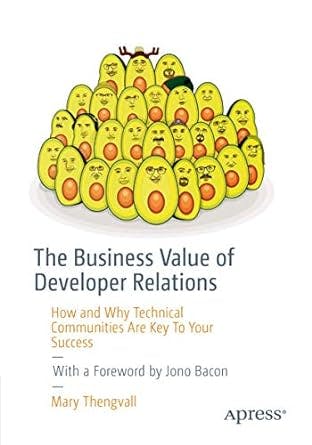
If you're new to Developer Relations (DevRel), "Building Developer Communities" is a helpful guide about why connecting with developers matters for companies.
It talks about how DevRel professionals connect companies with developers, making friends and sharing about products. It's about creating a group of people who think alike and help each other out. Before starting, it asks why you want this group, what's the plan, and who's in it. DevRel includes different roles, from leaders making plans to tech people who know both the product and what developers need.
It highlights that making friends isn't just about selling; it's about making real connections and getting people excited about the product. But having a DevRel team isn't a quick fix; it needs help from Marketing, Product, and Engineering. Different team members have different jobs, from big plans to making friends and learning about tech.
Instead of starting from scratch, it's smarter to join where customers already hang out. Listening, solving problems, and staying connected are really important when creating a group.
In the end, it's not just about the product, but about using your group and telling people about your company. Making your company known needs help from everyone in your group.
10. The Alchemist by Paulo Coelho

This famous book tells a deep story about learning and thinking about life. It shows how someone follows their dreams even when things get tough.
It identifies four main obstacles to pursuing our aspirations. First is the conditioning from childhood that deems our dreams impossible. Second, love can become an obstacle when it interferes with our pursuit of personal legends. Third is the fear of encountering defeats along the way, and finally, the fear of realizing our dreams after a lifelong struggle.
It explores the paradox of how individuals often offer advice on how others should live their lives but struggle to discern their paths, suggesting that many abandon their true callings prematurely. It emphasizes the concept that everything possesses a soul, from the elements to thoughts, the interconnectedness of life and the importance of understanding the soul of the world to interpret its language.
The Alchemist shares insights on the power of words and the importance of mindful speech, stressing that the true evil lies not in what enters one's mouth but in what is uttered. It dissects the relationship between love and pursuing one's Personal Legend, asserting that genuine love doesn't deter one from one's path but encourages it. The narrative unfolds the concept of beginner's luck at the start of a quest and the subsequent challenges that test the victor, illustrating the cycle of trials and triumphs on the path to fulfilling one's dreams.
The book suggests that the fear of failure is the sole factor that renders a dream unattainable, underscoring the importance of overcoming this fear to realize one's aspirations. It also highlights the significance of living in the present moment, emphasizing that life's essence lies in the current instant, encouraging a celebratory approach to life's journey.
11. How to Win Friends and Influence People by Dale Carnegie
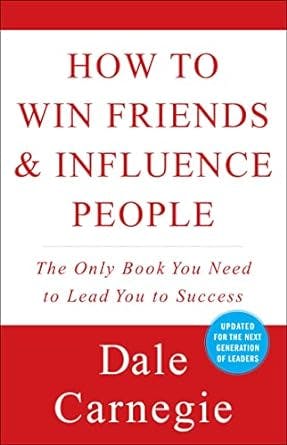
Dale Carnegie's "How to Win Friends and Influence People" offers timeless principles applicable to various life scenarios. In Part 1, Carnegie emphasizes fundamental techniques for handling people. The core principles—avoiding criticism, offering genuine appreciation, and arousing an eager want in others—serve as foundational pillars for effective communication and relationship-building.
The book highlights the importance of understanding human motivations. Refering to Freud's theories about the two fundamental motives driving human behavior: the desire for intimacy and the pursuit of greatness. By acknowledging these motives, we gain insight into human behavior and can better navigate interactions.
Part 2 highlights six ways to make people like you, focusing on the power of genuine interest in others, selflessness, and the impact of a simple smile. The notion of making others feel important, using their names, and expressing genuine admiration resonates throughout this section.
In Part 3, Carnegie offers insights into winning people over to your way of thinking. He advises against arguing, emphasizing the futility of winning an argument while losing goodwill. Instead, he promotes understanding, empathy, and tact in discussions, encouraging individuals to see things from others' perspectives.
The book then delves into strategies for changing people without causing offense or resentment. Techniques like indirect criticism, highlighting one's own mistakes before pointing out others', and encouraging positive behavior aim to influence without creating negativity.
Furthermore, It touches on maintaining a happy home life by avoiding criticism, offering honest appreciation, and acknowledging the importance of understanding and nurturing intimate relationships.
12. Deep Work by Cal Newport

This book champions the cultivation of a focused, undistracted mindset, presenting strategies to combat the pervasive distractions of the digital age and harness the transformative power of concentrated, purpose-driven work.
It introduces the concept of "Attention Restoration Theory," which highlights the benefits of spending time in nature to improve concentration, emphasizing the importance of regular mental rest for enhancing deep work quality. Multitasking erodes concentration and working memory, hindering one's ability to concentrate effectively.
It emphasizes the need to rewire the brain to resist distracting stimuli. Productive meditation, engaging in physical but not mentally demanding activities while focusing on specific professional problems, can bolster concentration and problem-solving abilities.
It also suggest for drastic measures like internet sabbaticals to counter the pervasive distraction caused by social media and infotainment. It suggests evaluating the utility of online tools by weighing their positive and negative impacts on professional and personal goals.
The author encourages a deliberate evaluation of the value of social media and online tools by conducting a 30-day detox. After this period, consider whether abstaining from these services has notably improved your life or whether people have missed your presence on these platforms. It concludes with an insightful perspective on channeling your mind into meaningful activities throughout the day, promoting fulfillment and relaxation by engaging in purposeful endeavors.
Closing Thoughts
One of my biggest successes this year would be having the courage to read twelve books with an average of 260 pages. Although there were about three books, I started reading but stopped halfway through for some reasons. It is also worth noting that I gained valuable insights, knowledge, and experience from them.
I would also like to recommend some great non-fiction books I have read in previous years.
No Excuse by Brian Tracy.
The Enemy Called Average by John Mason.
Think and Grow Rich by Napoleon Hill.
Gifted Hands by Ben Carson.
The Subtle Art of Not Giving a F*ck by Mark Manson.
48 laws of power by Robert Greene.
Rich Dad, Poor Dad.
Why Ask Why by John Mason.
Stealing Like An Artist by Austin Kleon.
Which of the books mentioned in this write-up is your favorite and/or you would add to your to-read list? Let me know in the comments section. Happy Holiday!

